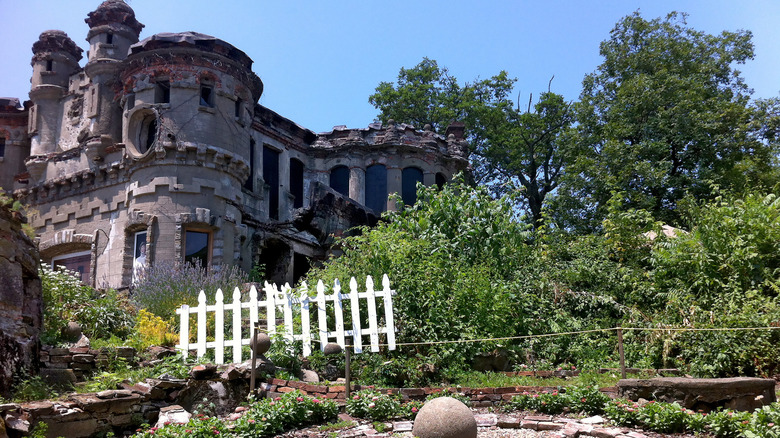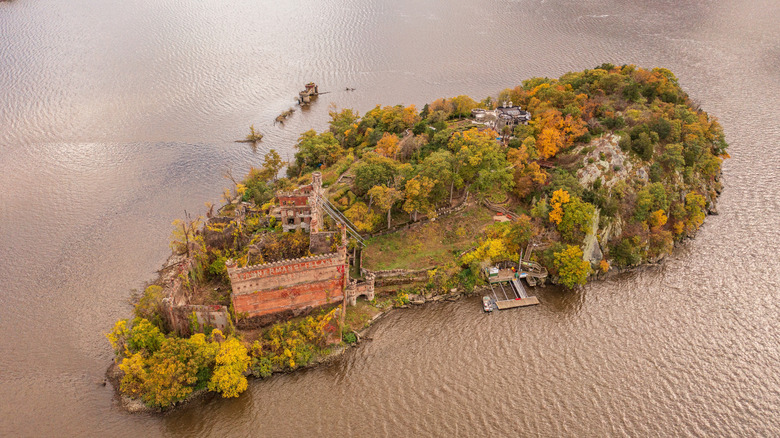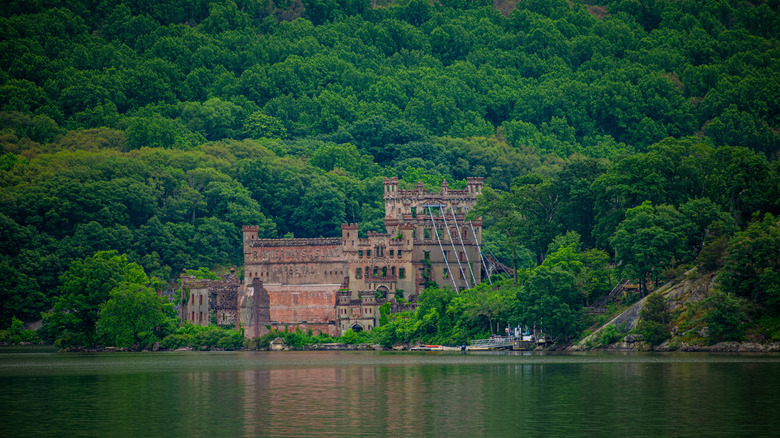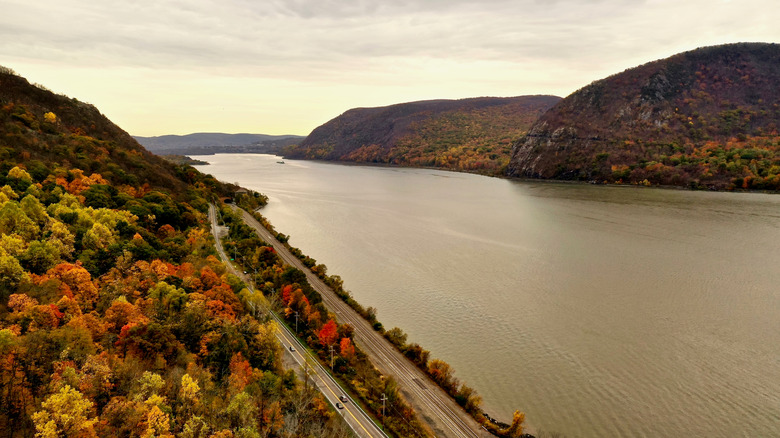The Strange Story Of New York's Abandoned Castle On A Haunted Island
"The captains of the river craft talk of a little bulbous-bottomed Dutch goblin, in trunk hose and sugar-loafed hat, with a speaking trumpet in his hand ... They declare they have heard him, in stormy weather, in the midst of the turmoil, giving orders in Low Dutch for the piping up of a fresh gust of wind." Such were the tales of tiny Pollepel Island midway down the Hudson River, where the river narrows north of modern-day West Point. That is, according to the 1822 short story short story, "The Storm Ship," by author Washington Irving. It took another 78 years for a real-life mystery to spawn on that tiny, rocky speck sitting in the middle of the Hudson.
Back then in 1900, Scottish immigrant Francis Bannerman and his son David bought Pollepel Island and began construction on Bannerman Castle, a structure meant to imitate the castles of Bannerman's homeland. But Bannerman Castle wasn't a home or fortress. It was a storage facility with an interesting visual design. Bannerman used it for his business, which traded in surplus military goods from the U.S. Civil War (1861 to 1865) through World War I (1914 to 1918). After Bannerman's 1918 death, a freak explosion of stored munitions blew apart much of the castle, followed by storms, fires, vandalism, and more in the following decades. Nowadays, the Bannerman Castle Trust maintains the castle as a tourist site.
But neither Bannerman nor Irving might have known about the Native American legends surrounding the island. To natives, it was a haunted place.
A haunted island turned haunt of the goblin king
Granted, we don't know much about the Native American tales surrounding Pollepel Island. Even the very idea of "Native American tales" about a haunted something-or-other sounds fabricated and cliché. But, if sources are to be believed, local tribesmen avoided the island for some spooky reason or another. The Bannerman Castle homepage says that folks on the run from tribesmen escaped to the island because their pursuers wouldn't venture there. The Little House of Horrors says that Native Americans avoided the island primarily after dark. Historic Hudson River Towns, meanwhile, talks about "spirits and goblins" on the island and leaves it at that.
It's this last point — especially goblins — that connects to the area's Dutch settlers, and even to Washington Irving's 1822 short story we quoted earlier, "The Storm Ship." For those not in the know, New York was originally called New Amsterdam. Before the English arrived and took things over, the Dutch settled along the Hudson and founded "Niuew Nederland" (in Dutch), which lasted from 1614 to 1674 and had New Amsterdam as its capital. Even by the time New York-born author Washington Irving lived (1783 to 1859), the memory of New Amsterdam was still strong.
Irving mentions the area's Dutch heritage quite often in his writings. The "little bulbous-bottomed Dutch goblin" in his short story, "The Storm Ship," refers to Dutch folklore about Pollepel Island. Like the Native Americans before them, the Dutch considered the island haunted. One story featured the king of the goblins, the Lord of Dunderberg, who used Pollepel Island to accept sacrifices.
Dutch tales of drunkenness, horror, and romance
Even though a goblin king named the "Lord of Dunderberg" makes for a memorable story, it's just one Dutch tale out of many regarding Pollepel Island. In the tale, drunk people got dropped off on Pollepel as sacrifices to keep the goblin king happy. Dutch sailors also reportedly feared the island because of sudden storms in the area sent by "The Storm King," a mysterious entity whose storms cloaked ships full of roving, savage goblins.
A less folklorish take on these goblin stories says that drunken sailors were deposited on the island to sober up, and then retrieved later. The island was uncomfortable, a bit frightening, and maybe the sailors made up stories about beasties lurking in the night. In this version, a drunken sailor was called a "pollepel." Oddly enough, "pollepel" is actually a Dutch word for ladle, even to this day. How and if this connects to Pollepel Island's moniker — the shape of the island, perhaps — is anyone's guess.
In another linguistic tale, a girl named Polly Pell almost fell through the ice on the Hudson while playing on it, but survived thanks to her proximity to the island — hence the homophonic Pollepel Island. Another version of this story turns full Disney and finds the young Polly rescued by her beau, who was apparently on the island already. He and Polly get married on the spot. At this point, we've steered far from haunted island tales, but that would change with Scottish immigrant and businessman, Francis Bannerman.
The abandoned Bannerman arms depot
It's unknown whether Francis Bannerman and his son, David, knew anything about native or Dutch stories regarding Pollepel Island's supposedly haunted status. As the Bannerman Castle website tells the tale, David spotted the island in the distance while he and his father were canoeing along the Hudson, and bought it. Bannerman wanted to use the tiny outcrop as a safe spot to store munitions, military equipment, and scrap metal that he bought and sold for his business. And while we refer to the building he constructed as a "castle," that's a bit of a stretch. It's more of a stone manor house inspired by Scottish castles than any castle you'd find in Scotland. And even though Bannerman Castle isn't a residence, Bannerman did build a separate, smaller family residence away from the castle, where his family stayed through the 1930s.
But well before then, Bannerman Castle had already fallen victim to bad luck. Construction on the castle wasn't finished by the time of Bannerman's death in 1918. Then, a couple years later, 200 pounds of Bannerman's storehouse munitions detonated and annihilated part of the castle. After the family moved away, a storm destroyed the ferry to the island in 1950. The island's attendant left by 1957, and the state of New York bought the property. That's when vandals and fires hit Pollepel Island, like one fire in 1969 that burned for three days. All of this ruin and destruction has left us with the shell of Bannerman Castle that we see today, a sight that inspires talk of spirits, goblins, and hauntings.
Haunted tourist site and strange riverside oddity
At present, Bannerman Castle stands out not only because structures like castles are exceedingly rare in a country as new as the United States, but because the castle isn't tucked away in a remote location in an overgrown forest somewhere. It's actually visible from New York's Route 9d, which runs really close to the Hudson River and Pollepel Island. You could potentially grab a canoe and row out to the island, or just gaze at it from a distance while on a hike. Just don't wander on the island while drunk unless you want the goblin king to snatch you up.
Bannerman Castle is actually something of a tourist hotspot at present and has a lot of good reviews on Tripadvisor. The Bannerman Castle website also has loads of tour packages available to pay the haunted locale a visit, which illustrates how business savvy are the operators of the Bannerman Castle Trust. There's a cruise and walking tour, a kayaking tour, a butterfly-watching tour, a self-guided tour with folk musicians playing in the background, a Shakespeare festival on the island, a pricey farm-to-table dinner featuring a five-course meal, Memorial and Labor Day cruise specials, and even open-air, outdoor movie nights. We're guessing those last folks didn't catch wind of the Native American warnings about not stepping on the island after dark. Haunted or not, it's a strange end to a strange story about the strange tales spawned by a little island once considered terrifying.




